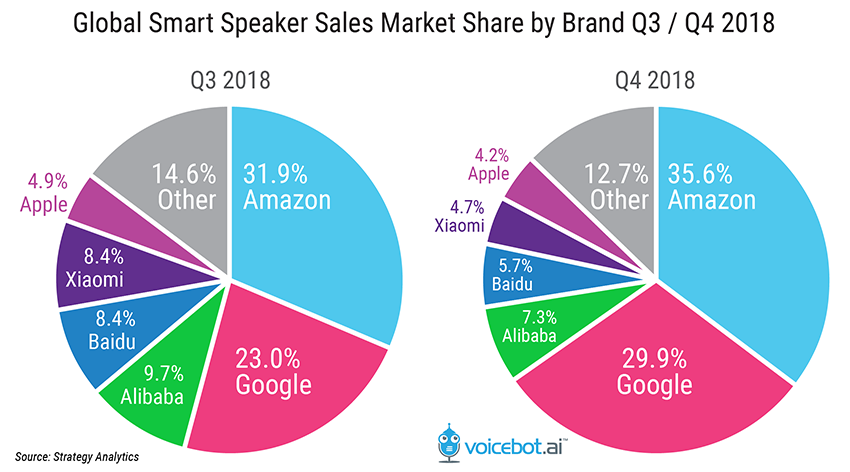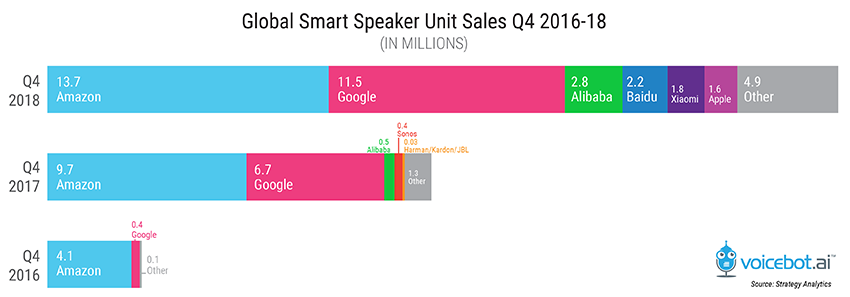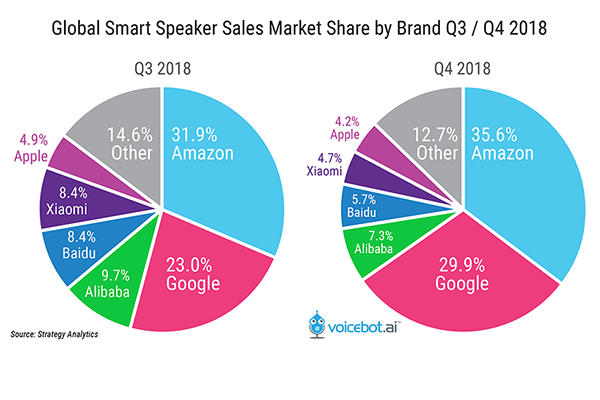Amazon Increases Global Smart Speaker Sales Share in Q4 2018, While Google’s Rise Narrows the Gap and Apple Declines
- Amazon’s global smart speaker sales share rose in Q4 2018 to 35.6% compared to 31.9% in Q3 2018
- Google’s smart speaker sales also rose between Q3 and Q4 from 23% to 29.9% and narrowed the gap with Amazon
- Apple’s share of smart speaker sales declined to 4.2% from 4.9% in Q3, but its 1.6 million units sold in Q4 generated more than $500 million in quarterly revenue
- Smart speaker sales grew 70% in Q4 compared to Q3 2018 and rose more than 100% over Q4 2017
- Strategy Analytics says there were more smart speakers sold worldwide in Q4 2018 than in all of 2017
Amazon increased its lead in global smart speaker sales in Q4 2018 according to research firm Strategy Analytics. The Amazon Echo product line accounted for 35.6% of total global smart speaker sales in the fourth quarter up from 31.9% in Q3 2018. Google Home devices were second in the category in both quarters and rose from just 23% to 29.9% between the third and fourth quarters. Meanwhile, Apple HomePod sales fell from 4.9% to 4.2% of sales unit volume.

The biggest mover on a relative basis was Chinese device maker Baidu. In Q2 2018, Baidu had virtually zero smart speaker sales. That changed markedly in Q3 when it debuted on the charts with 8.4% in a tie with Xiaomi. Baidu didn’t have the same holiday shopping tailwinds as Amazon and Google in western nations in Q4, but still posted 5.7% of all smart speakers sold and placed well ahead of Xiaomi. Alibaba continued to lead in China.
Smart Displays Help Drive Unit Sales
On an absolute basis, more smart speakers were sold in Q4 2018 than in the full year 2017. The Q4 2018 sales exceeded Q3 2018 by 70% and were more than 100% higher than Q4 2017. David Watkins a director at Strategy Analytics said smart displays were popular and helped drive some of the increased sales volume:
Smart displays such as Google’s Home Hub, Amazon’s Echo Show and Baidu’s Xiaodu Zaijia are proving popular with consumers who are attracted by the combination of audio and visual stimulus and the wider range of use cases compared to speaker only devices. Smart displays made up more than 10% of total shipment demand in Q4 2018 and they are expected to be a significant driver of growth in the market through 2019
Google Narrows the Smart Speaker Market Share Gap with Amazon
Google placed second in device sales but is clearly narrowing the gap with Amazon. Between Q3 and Q4 2018, Google narrowed Amazon’s relative lead from 8.9% of market share to just 5.7%. Even more impressive is Google’s progress since Q4 2016 when it first started selling smart speakers. Google Home moved less than 10% of the total Amazon Echo sales volume in 2016. In that year, Google faced three challenges. The device was new so Google had to build awareness. The product didn’t start shipping until the first week in November which offered it a one-third less time to drive sales than Amazon. And, Google only had a single device that sold for more than $100, while Amazon Echo Dot sold for under $50. Things changed in 2017.

By Q4 2017, Google had a high-end device for audiophiles, the Google Home Max, and a low-priced device to compete with the Amazon Echo Dot called Google Home Mini. Despite moving toward parity from a product portfolio standpoint, Amazon still sold 50% more devices than Google at the end of 2017. In Q4 2018, Google only trailed Amazon smart speaker sales by 19%. This is good news for Google overall. However, it should be noted that Google Home offered localized versions in 19 countries at the end of 2018 compared to 14 for Amazon Echo. You can buy these devices in other countries without localization, but for target markets, Google actually has access to more potential buyers than Amazon and still sold fewer units. So, the story for Google is great from a global perspective, but Amazon is still competing well in the markets it serves.
What Happened to Apple HomePod?
Apple HomePod lost relative market share in Q4 2018 according to the Strategy Analytics analysis falling from 4.9% in Q3 to just 4.1% in Q4. What might have caused this? First, Strategy Analytics reports unit volume sales. At the Q4 discount price, consumers could purchase about 14 Google Home Minis or Amazon Echo Dots for the price of a single HomePod. Even when the HomePod is on sale, and it rarely is in quantity, the price differential is 10-to-1. Pricing alone makes unit volume a tough comparison for Apple. However, that 1.6 million units drove over $500 million in Q4 revenue. By contrast, Amazon’s 13.7 million units sold likely only brought in about $800-$900 million in revenue. That is only about 0.6-0.8 more in revenue for 8.5 times more unit volume.
A second issue facing Apple is that it didn’t have anything new to offer. HomePod launched in most of its markets in the first half of 2018. That is the same device available in Q4 2018. By contrast, Google introduced a new smart display, Amazon upgraded its smart display and both companies had several models to choose from. Google and Amazon had new products on offer at a time when many shoppers are looking for new. As Apple shifts it focus away from iPhone to services, it will need a new device strategy for the home. Services need distribution and there are too few HomePods to act as a strong sales and delivery channel. That is why you saw Apple Music arrive on Amazon Alexa in time for the holidays. Aside from using partnerships, Apple will benefit from providing more options for consumers to adopt Apple smart speakers at a lower price point in 2019.
Follow @bretkinsella Follow @voicebotai
Strategy Analytics Reports Explosive Smart Speaker Growth in Q4, 30 Million Units in 2017
Juniper Forecasts $80 Billion in Voice Commerce in 2023, or $10 Per Assistant









